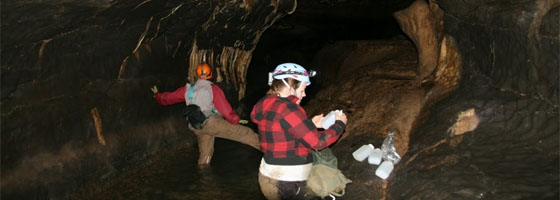Karst aquifer research aims to reduce Puerto Rico preterm births

Dorothy Vesper can truly say that her research is affecting the future. The West Virginia University geology professor participates in PROTECT, the Puerto Rico Testsite for Exploring Contamination Threats. The PROTECT program researches the effects of environmental contaminants on preterm births.
Puerto Rico has the highest preterm birth rate of any U.S. territory, and one of the highest of all world countries, at 20 percent. Puerto Rico has 150 contaminated waste sites, 14 of which are active Superfund sites; the team is investigating if water quality has any relationship to the preterm birth problem. The Superfund-relevant toxicants have been linked to problematic births, including preterm birth, defined as less than 37 weeks of gestation. This waste enters groundwater supplies and many, including expectant mothers, consume the water. Vesper and her team study how these chemicals move through groundwater, specifically in karst aquifers.
Karst systems include the surface and subsurface landscapes formed by water flowing through soluble rock, most often limestone. Karst aquifer systems provide nearly 20 percent of the world’s population with drinking water, including many in Puerto Rico.
Vesper and a graduate student, Amanda Laskoskie, are studying how to track these contaminants as they move in the Puerto Rico karst aquifer system – at home in West Virginia. After attending a PROTECT retreat in Puerto Rico, Laskoskie took a trip to Buckeye Cave, part of a more local karst aquifer.
“What we’re trying to look at is – can we develop tools that allow us to test in a cave system how those tracking mechanisms will work,” Vesper said.
Laskoskie developed a rather bright idea for a tool. To look at how contaminants move, she collaborated with Department of Energy microbiologist Harry Edenborn to create floating hydrogel beads made from biodegradable marine algae. The beads fluoresce under UV lights due to an added pigment, so when Laskoskie and Vesper walk through a cave to track the beads in water, they can see them with a UV flashlight. This system reveals where contaminants could get hung up in the underground water system and how quickly and in what direction they move. They also monitor cave waters using YSI’s Pro Plus and 556 handheld meters and In-Situ Trolls.
Knowledge gained from the local research site will be used as a model for contaminant transport in the Puerto Rico karst.
“It’s much smaller, but what it lets us do is test out these methods in a much more controlled setting,” Vesper said.
Laskoskie is now testing the hydrogel beads at different densities to demonstrate how many different types of contaminants will move through the waters in Puerto Rico.
“Altering the physical properties of the beads will allow us to mimic the properties of different types of contaminants,” Laskoskie said in a WVU press release. “This will allow us to better understand their fate and how they are transported, improving our ability to remediate polluted sites.”
The multidisciplinary PROTECT program is funded by the National Institute of Environmental Health Sciences’ Superfund Research Program. Vesper’s projects focus on contaminant transport and are closely linked with those of PROTECT collaborators Akram Alshawabkeh from Northeastern University and Ingrid Padilla from the University of Puerto Rico, Mayagüez. Researchers from other universities and teams are studying the medical effects of the local contaminants on people, including an infant cohort study. All the research will culminate to mitigate the social and medical issue of the high preterm birth rate in Puerto Rico.
“From my standpoint it’s really exciting to interact with these people with very different specialties,” Vesper said.
Preterm births greatly increase the risk of the mother and infant dying; it is the cause of mortality in one out of every three infant deaths. PROTECT’s goal is to reduce preterm births to 7.6 percent.




0 comments